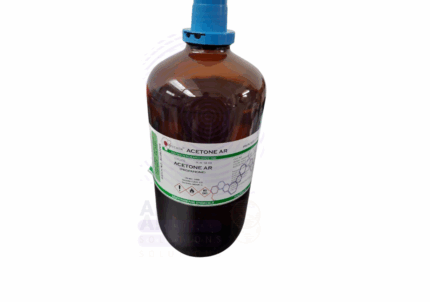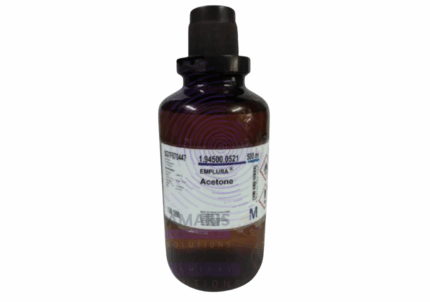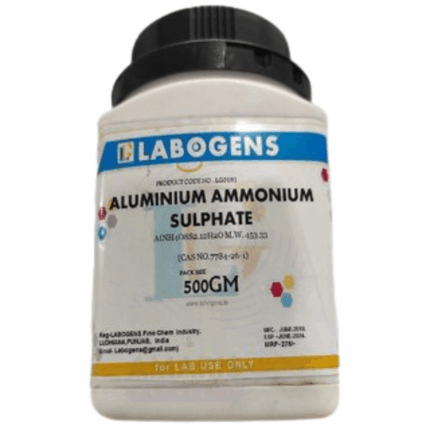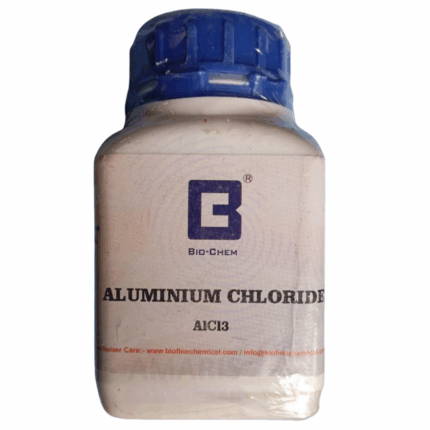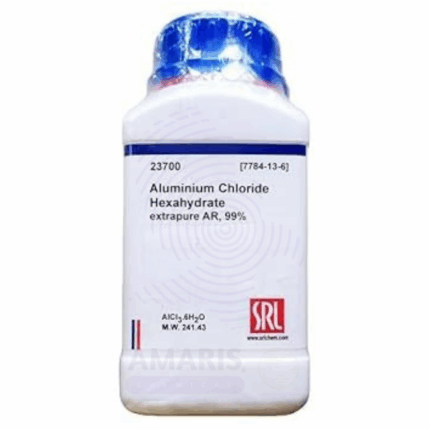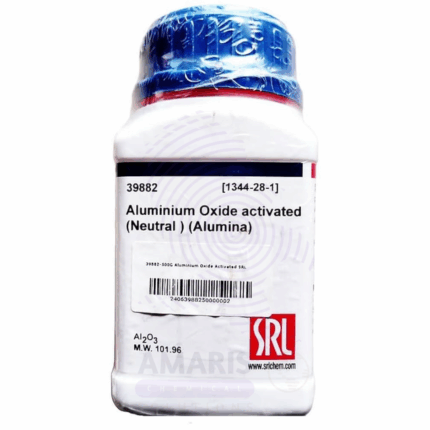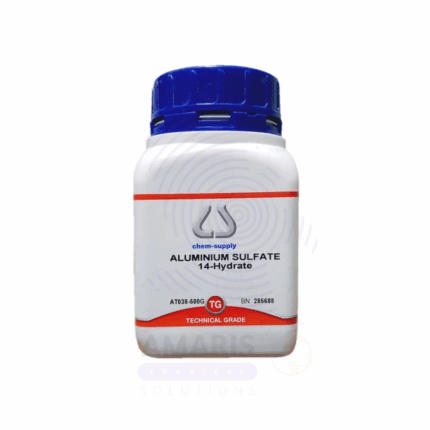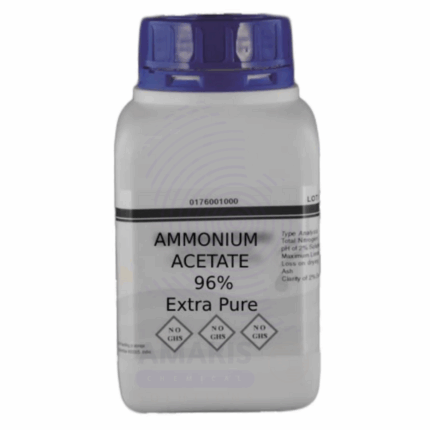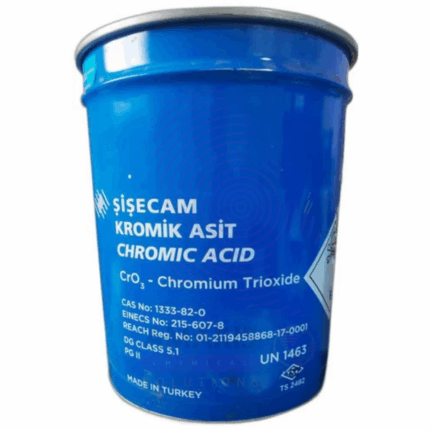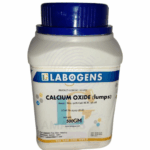
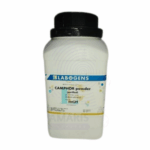
Calcium Sulphate Dihydrate Extra Pure
$ 18.00 Original price was: $ 18.00.$ 17.45Current price is: $ 17.45.
Calcium Sulphate Dihydrate Extra Pure is a high-purity, white crystalline compound commonly used in laboratory settings for controlled experiments involving hydration and crystallization. Also known as gypsum, it serves as a reliable source of calcium and sulfate ions in analytical chemistry and is often used in preparing culture media, setting-time studies, and thermogravimetric analysis. Its stable dihydrate form makes it ideal for demonstrating water crystallization and thermal decomposition when converted to hemihydrate or anhydrous forms. The extra pure grade guarantees minimal impurities, ensuring accuracy in sensitive applications. It should be stored in a cool, dry place to maintain its hydration state and analytical integrity.
Calcium Sulphate Dihydrate Extra Pure
Primary Uses
- Standard for Quantitative Analysis
- Used as a primary standard in gravimetric and sulfate precipitation experiments due to its known composition and stability.
- Casting & Molding Medium
- Commonly utilized in preparation of molds and casts for biological specimens, fossils, or impressions during demonstrations and teaching.
- Reagent in Chemical Synthesis
- Employed as a source of calcium ions in the preparation of other calcium salts under mild aqueous conditions.
- Study of Crystallization Processes
- Used in crystallography and recrystallization demonstrations, especially to illustrate water of crystallization concepts.
- Educational Demonstrations of Hydration/Dehydration
- Heated to form calcium sulfate hemihydrate or anhydrous form, demonstrating reversible hydration processes.
Secondary Uses
- pH Buffer Component
- Occasionally used in combination with other salts to stabilize pH in controlled systems.
- Soil Chemistry Simulations
- Incorporated in agricultural lab tests to mimic gypsum effects in soil leaching or remediation studies.
- Substrate for Microbial Growth Studies
- Added to certain growth media to study calcium ion effects on microorganisms (less common).
- Thermal Behavior Studies
- Included in thermal gravimetric analysis (TGA) to assess water loss upon heating and phase change behavior.
| PACK SIZE |
500 grams Plastic Tin |
|---|
1. Basic Identification Attributes
- Chemical Name: Calcium Sulphate Dihydrate
- Chemical Formula: CaSO₄·2H₂O
- CAS Number: 10101-41-4
- HS Code: 2833.29.90
- Grade: Extra Pure (Laboratory Grade)
- Synonyms: Gypsum, Hydrated calcium sulfate, Terrestrial gypsum
2. Physical & Chemical Properties
- Appearance: White crystalline powder
- Odor: Odorless
- Molar Mass: 172.17 g/mol
- Solubility in Water: Slightly soluble (~0.24 g/100 mL at 25°C)
- Density: ~2.32 g/cm³
- Melting Point: Decomposes before melting (~1450 °C)
- pH (saturated solution): ~6–7
3. Safety & Hazard Attributes
- GHS Classification:
- Not classified as hazardous under GHS for lab-scale use
- GHS Pictograms: None required
- Hazard Statements:
- May cause mild irritation to eyes or respiratory tract if inhaled as dust
- Precautionary Statements:
- Avoid generating dust
- Use appropriate PPE when handling in powdered form
4. Storage & Handling Attributes
- Storage Conditions:
- Store in a cool, dry place
- Keep container tightly closed
- Protect from moisture (to avoid caking or premature dehydration)
- Packaging: Plastic jars or poly-lined containers for laboratory use
- Handling Precautions:
- Use dust masks and eye protection
- Avoid inhalation or prolonged contact with skin
5. Regulatory & Compliance Attributes
- Transport Classification:
- Not regulated as a hazardous material
- Disposal Considerations:
- Dispose of according to local environmental regulations
- Can typically be discarded with regular laboratory waste if uncontaminated
6. Environmental & Health Impact
- Toxicity:
- Low toxicity; considered safe in small quantities
- Ecotoxicity:
- Not known to be environmentally hazardous
- Biodegradability: Not applicable — inorganic salt
- Fumes/Dusts:
- Inhalation of fine particulate can be mildly irritating
SAFETY PRECAUTIONS
- Personal Protective Equipment (PPE):
- Wear safety goggles, lab coat, dust mask or respirator (if airborne particles are present), and gloves.
- Handling:
- Avoid generating dust.
- Use only with adequate ventilation or under a fume hood.
- Wash hands thoroughly after handling.
- Storage:
- Store in a cool, dry, and well-ventilated area.
- Keep container tightly closed when not in use.
- Protect from moisture to avoid clumping or caking.
FIRST AID MEASURES
- Inhalation:
- Move person to fresh air.
- Seek medical advice if respiratory symptoms develop.
- Skin Contact:
- Wash thoroughly with soap and water.
- Remove contaminated clothing.
- If irritation occurs, get medical advice.
- Eye Contact:
- Rinse cautiously with plenty of water for at least 15 minutes.
- Remove contact lenses if present and easy to do.
- Seek medical attention if irritation persists.
- Ingestion:
- Rinse mouth with water.
- Drink water to dilute.
- Not expected to be toxic, but seek medical attention if symptoms occur.
FIRE FIGHTING MEASURES
- Flammability:
- Non-flammable.
- Extinguishing Media:
- Use water spray, foam, dry chemical, or CO₂ — appropriate for surrounding fire.
- Hazardous Combustion Products:
- May emit sulfur oxides when heated to decomposition.
- Firefighter Protection:
- Wear SCBA and full protective gear if involved in fire conditions.


 Preservatives(food)
Preservatives(food) Flavor Enhancers
Flavor Enhancers Acidulants
Acidulants Sweeteners
Sweeteners Antioxidants
Antioxidants Colorants(food)
Colorants(food) Nutraceutical Ingredients (food)
Nutraceutical Ingredients (food) Nutrient Supplements
Nutrient Supplements Emulsifiers
Emulsifiers
 Collectors
Collectors Dust Suppressants
Dust Suppressants Explosives and Blasting Agents
Explosives and Blasting Agents Flocculants and Coagulants
Flocculants and Coagulants Frothers
Frothers Leaching Agents
Leaching Agents pH Modifiers
pH Modifiers Precious Metal Extraction Agents
Precious Metal Extraction Agents
 Antioxidants(plastic)
Antioxidants(plastic) Colorants (Pigments, Dyes)
Colorants (Pigments, Dyes) Fillers and Reinforcements
Fillers and Reinforcements Flame Retardants
Flame Retardants Monomers
Monomers Plasticizers
Plasticizers Polymerization Initiators
Polymerization Initiators Stabilizers (UV, Heat)
Stabilizers (UV, Heat)
 Antifoaming Agents
Antifoaming Agents Chelating Agents
Chelating Agents Coagulants and Flocculants
Coagulants and Flocculants Corrosion Inhibitors
Corrosion Inhibitors Disinfectants and Biocides
Disinfectants and Biocides Oxidizing Agents
Oxidizing Agents pH Adjusters
pH Adjusters Scale Inhibitors( water)
Scale Inhibitors( water)
 Antioxidants(cosmetic)
Antioxidants(cosmetic) Emollients
Emollients Fragrances and Essential Oils
Fragrances and Essential Oils Humectants
Humectants Preservatives
Preservatives Surfactants(cosmetic)
Surfactants(cosmetic) Thickeners
Thickeners UV Filters
UV Filters
 Fertilizers
Fertilizers Soil Conditioners
Soil Conditioners Plant Growth Regulators
Plant Growth Regulators Animal Feed Additives
Animal Feed Additives Biostimulants
Biostimulants Pesticides (Herbicides, Insecticides, Fungicides)
Pesticides (Herbicides, Insecticides, Fungicides)
 Active Pharmaceutical Ingredients (APIs)
Active Pharmaceutical Ingredients (APIs) Excipients
Excipients Solvents(pharmaceutical)
Solvents(pharmaceutical) Antibiotics
Antibiotics Antiseptics and Disinfectants
Antiseptics and Disinfectants Vaccine Adjuvants
Vaccine Adjuvants Nutraceutical Ingredients (pharmaceutical)
Nutraceutical Ingredients (pharmaceutical) Analgesics & Antipyretics
Analgesics & Antipyretics
 Analytical Reagents
Analytical Reagents Solvents(lab)
Solvents(lab) Chromatography Chemicals
Chromatography Chemicals Spectroscopy Reagents
Spectroscopy Reagents microbiology-and-cell-culture-reagents
microbiology-and-cell-culture-reagents Molecular Biology Reagents
Molecular Biology Reagents Biochemical Reagents
Biochemical Reagents Inorganic and Organic Standards
Inorganic and Organic Standards Laboratory Safety Chemicals
Laboratory Safety Chemicals Specialty Laboratory Chemicals(Special Laboratory Equipment)
Specialty Laboratory Chemicals(Special Laboratory Equipment)
 Demulsifiers
Demulsifiers Hydraulic Fracturing Fluids
Hydraulic Fracturing Fluids Scale Inhibitors(oil)
Scale Inhibitors(oil) Surfactants(oil)
Surfactants(oil) Drilling Fluids
Drilling Fluids
 Dyes and Pigments
Dyes and Pigments Bleaching Agents
Bleaching Agents Softening Agents
Softening Agents Finishing Agents
Finishing Agents Antistatic Agents
Antistatic Agents
 Admixtures
Admixtures Waterproofing Agents
Waterproofing Agents Sealants and Adhesives
Sealants and Adhesives Curing Compounds
Curing Compounds Concrete Repair Chemicals
Concrete Repair Chemicals Anti-Corrosion Coatings
Anti-Corrosion Coatings
 Surfactants(cleaning)
Surfactants(cleaning) Builders
Builders Enzymes
Enzymes Solvents (Cleaning)
Solvents (Cleaning) Fragrances
Fragrances
 Electronic Chemicals
Electronic Chemicals Catalysts
Catalysts Lubricants
Lubricants Photographic Chemicals
Photographic Chemicals Refrigerants
Refrigerants Automotive chemicals
Automotive chemicals Pyrotechnic Chemicals
Pyrotechnic Chemicals
 Biodegradable Surfactants
Biodegradable Surfactants Bio-based Solvents
Bio-based Solvents Renewable Polymers
Renewable Polymers Carbon Capture Chemicals
Carbon Capture Chemicals Wastewater Treatment Chemicals
Wastewater Treatment Chemicals
 Pigments
Pigments Solvents(paint)
Solvents(paint) Specialty Coatings
Specialty Coatings Binders/Resins
Binders/Resins Additives
Additives Driers
Driers Anti-Corrosion Agents
Anti-Corrosion Agents Functional Coatings
Functional Coatings Application-Specific Coatings
Application-Specific Coatings
 Fresh Herbs
Fresh Herbs Ground Spices
Ground Spices Whole Spices
Whole Spices Spice Blends
Spice Blends Dried Herbs
Dried Herbs
 Leavening Agents
Leavening Agents Dough Conditioners
Dough Conditioners Flour Treatments
Flour Treatments Fat Replacers
Fat Replacers Decoratives
Decoratives Preservatives(baking)
Preservatives(baking)
 Plasticizers & Softeners
Plasticizers & Softeners Reinforcing Agents
Reinforcing Agents Adhesion Promoters
Adhesion Promoters Vulcanizing Agents
Vulcanizing Agents Antidegradants
Antidegradants Blowing Agents
Blowing Agents Fillers & Extenders
Fillers & Extenders Accelerators & Retarders
Accelerators & Retarders

